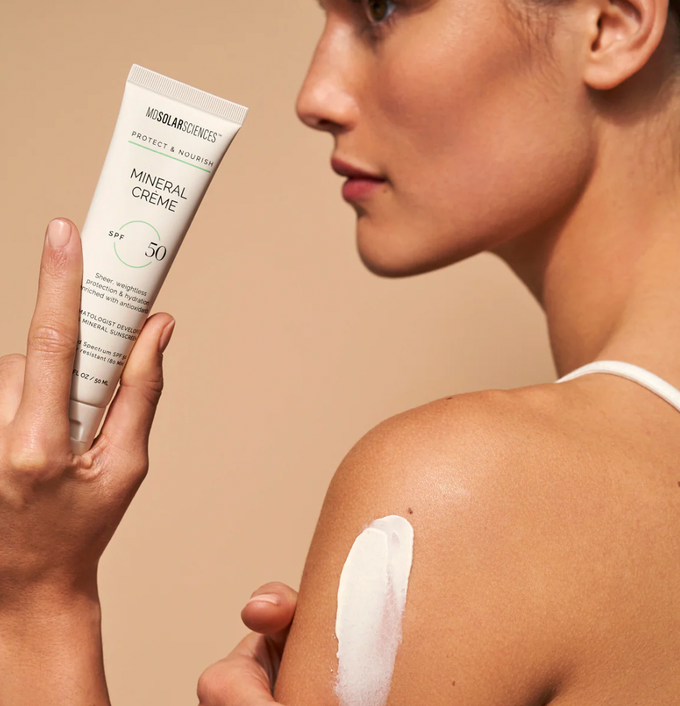Understanding the Science Behind Skin Damage

Sunlight has numerous benefits for your health. This includes helping you keep your sleeping patterns on track and production of Vitamin D, which you need for proper bone health. However, too much UV exposure is also damaging to your skin.
Understanding the science behind sun damage will help you comprehend why sun protection is so important. Read along as we go over the science behind skin damage and share helpful tips from board-certified dermatologists on how to protect yourself from the sun's UV rays.
UV Rays and Skin Damage
Here's a basic breakdown of how UV rays work:
UVA rays penetrate the deeper layers of the skin, leading to premature aging, wrinkles, and contributing to skin cancer development.
UVB rays mostly affect the outer layer of the skin, causing sunburns and contributing to skin cancer risk.
Note: UV rays can cause skin damage all year round no matter what the weather is like!
According to board-certified dermatologist Dr. Andrea Taylor, MD, FAAD, "Sun protection is something that must be practiced year round. Many people assume when the weather cools down they are not getting harmful UV rays, but this is most definitely not the case. Seeking shade is helpful, but you must be mindful that UVB can reflect off of surfaces such as concrete and sand."
Effects of UV Radiation on the Skin
The interaction between UV radiation and the skin triggers various biological responses that can lead to both short-term and long-term skin damage:
Sunburns: UVB rays are primarily responsible for causing sunburn by damaging the DNA in skin cells, leading to inflammation and redness.
Premature Aging: UVA rays penetrate deeply, breaking down collagen and elastin fibers, resulting in wrinkles, fine lines, and leathery skin.
Hyperpigmentation: UV exposure can lead to the overproduction of melanin, causing dark spots and uneven skin tone.
Skin Cancer: Prolonged exposure to UV radiation is a significant risk factor for skin cancer, including melanoma, basal cell carcinoma, and squamous cell carcinoma.
Dr. Taylor broke this down even more for us:
"Over time, with chronic sun exposure, we will notice many changes in the skin. First, uneven pigmentation which can come in many forms from sun spots (lentigines) to white patches (idiopathic guttate hypomelanosis).
Sun damage may also lead to a condition called poikiloderma which is most common on the neck and chest and consists of lightened and darkened areas along with dilated blood vessels (telangiectasia) and thinning of the skin (atrophy).
You can also see the formation of premature wrinkling and a leathery texture to the skin. Actinic keratoses (or precancers) which manifest as red, scaly spots also result from long-term sun exposure."
How to Protect Your Skin from Sun Damage
Here are some suggestions from Dr. Taylor on how to protect your skin from sun damage:
Sunscreen: Use broad-spectrum sunscreen with SPF 30 or higher, applying it generously and reapplying every two hours or after swimming or sweating. She recommends sunscreen with a "physical blocker" such as zinc oxide or titanium dioxide.
Sun-Protective Clothing: Wear UPF 50+ hats and clothing that covers your skin, especially during peak sunlight hours.
Seek Shade: Limit direct exposure to the sun, especially between the hours of10 a.m. and 4 p.m. when UV rays are strongest.
Get Regular Skin Checks: Perform self-examinations and schedule annual skin screenings with a dermatologist to detect any changes or suspicious moles.
As Board-Certified Dermatologist Dr. Kimberly Jerdan, MD cautions people to make sure to do their annual skin exam. "I can't stress how important it is to have full-body skin examinations done by a board-certified dermatologist," she shared with us on an article we wrote on How to Take Precautions Against Skin Cancer.
Remember to Consult Your Dermatologist: For personalized advice and guidance regarding sun protection and skin health, consult with your dermatologist. We also have an entire series called Doc Talk where we interview dermatologists on our blog if you're looking for more information and support online.
Embrace Sun Safety to Keep Your Skin Healthy
Protect yourself from the harmful effects of UV radiation by wearing sunscreen, sun-protective clothing, and scheduling regular check ups with your dermatologist.
By understanding these effects and implementing protective measures, you can maintain healthier skin and reduce the risk of sun-related skin conditions and skin cancer.







